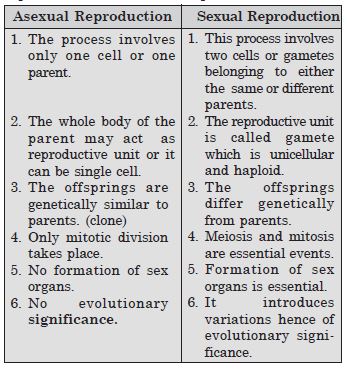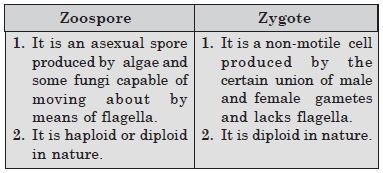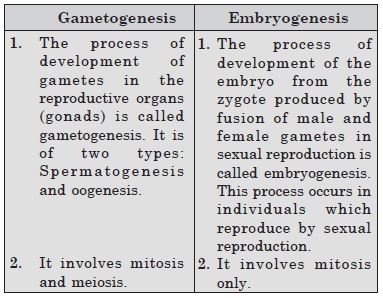Question 1:
Why is reproduction essential for organisms?
Answer:
Reproduction is a process by which an organism produces young ones of its own kind to maintain the continuity of the species. It enables the species to live generation after generation.
Question 2:
Which is better method of reproduction? Why? Will your opinion be affected by environmental factors present?
Answer:
(i) Sexual reproduction is better method of reproduction.
(ii) The organisms produced will show variations.
(iii) The variations thus developed help the organisms to adapt to the environment even in
the changes in those factors and enable them to survive.
(iv) Variations contribute to the evolution.
Question 3:
Why is the offspring formed by asexual reproduction referred to as clone?
Answer:
The offspring formed by asexual reproduction is referred to as clone because the offspring is morphologically and genetically similar to the parent.
Question 4:
Offspring formed due to sexual reproduction have better chances of survival, why ?
Answer:
The offspring formed due to sexual reproduction show variations due to crossing over during
gametogenesis, random segregation of gametes or random fertilization. These useful
variations
produced in offspring help the organisms to adapt and survive.
Question 5:
How does the progeny formed from asexual reproduction are different from those formed by sexual reproduction?
Answer:
The progeny formed from asexual reproduction is genetically similar to the parent while those formed by sexual reproduction is genetically different from parents due to new gene combinations formed during crossing over, random segregation and fertilization. Organisms reproducing sexually show Variations.
Question 6:
(i) Distinguish between asexual and sexual reproduction.
(ii) Why is vegetative reproduction also considered as a type of asexual reproduction?
Answer:
(i) Differences between asexual reproduction and sexual reproduction

(ii) Vegetative reproduction is also considered as a type of asexual reproduction because it
does not involve meiotic division and there is no formation and fusion of gamete.
In this case characters of parent plants are preserved.
Question 7:
What is vegetative propagation? Give two suitable examples.
Answer:
Vegetative propagation. Regeneration of new plants from plant portions of vegetative organs
is called vegetative propagation.
Examples 1. In Century plant (Agave sp.) flowers, buds develop into bulbils
which drop to the ground and develop into new plants.
2. Potato tubers possess buds which grow into new plants.
Question 8:
Define:
(i) juvenile phase
(ii) reproductive phase
(iii) senescence phase.
Answer:
(i) Juvenile phase. The period of growth in life of organisms before they start reproducing
sexually and attain a level of maturity is called juvenile phase. It is followed by
reproductive phase.
(ii) Reproductive phase. The period of active reproductive behaviour when the organisms show
marked morphological and physiological changes is called reproductive behaviour. It is
followed by senescence phase.
(iii) Senescence phase. The period when the reproductive phase ends and concomitant changes
occur in the body such as slowing of metabolism is called senescence phase. It is followed
by death.
Question 9:
Higher organisms have resorted to sexual reproduction inspite of its complexity. Why?
Answer:
Higher organisms have resorted to sexual reproduction inspite of its complexity because, at
the same time, sexual reproduction provides two-fold advantages. They are:
1. Genetic recombination, interaction etc. take place which cause variations in the
offsprings thus, also form raw materials for evolution.
2. The offsprings adapt more comfortably and quickly to the changes in environmental
conditions.
Question 10:
Explain why meiosis and gametogenesis are always interlinked.
Answer:
Gametes are haploid even the parent body from which they arise may be haploid or diploid.
Gametogenesis involves meiosis. In diploid organisms, specialised cells called meiocytes
(gamete mother cells) undergo meiosis. At the end of meiosis only one set of chromosomes get
incorporated into each gamete.
Question 11:
Define external fertilization. Mention its disadvantages.
Answer:
The fertilization in which the fusion of gametes occurs outside the body of the female in an
external medium i.e. water.
Examples. Bony fishes, amphibians etc. Organisms that exhibit external
fertilization show a great synchrony between the sexes in order to liberate the gametes at
the same time.
Disadvantages of external fertilization are:
(1) A large number of gametes are produced to ensure fertilization thus there is
wastage.
(2) The offsprings formed are extremely vulnerable to predators threatening their survival
upto adulthood.
Question 12:
Differentiate between a zoospore and a zygote.
Answer:
Differences between zoospore and zygote

Question 13:
Differentiate between gametogenesis and embryogenesis.
Answer:
Differences between gametogenesis and embryogenesis

Question 14:
What is a bisexual flower? Collect 5 bisexual flowers from your neighbourhood and write scientific names.
Answer:
Bisexual flower. A flower in which both the essential organs i.e. carpels and stamens are
present is called a bisexual flower.

Question 15:
Examine a few flowers of any cucurbit plant and try to identify the staminate and pistillate flowers. Do you know any other plant that bear unisexual flowers?
Answer:
The staminate flowers bear bright coloured petals and stamens. They do not develop fruits. The pistillate flowers develop fruits. The other examples of unisexual plants are Papaya, Date palm.
Question 16:
Why offsprings of oviparous animals are at a greater risk for survival ?
Answer:
1. Zygote develops outside body, thus chances of survival are reduced.
2. Oviparous animals are at a greater risk for survival because there is no parental care
and protection as in case of viviparous animals.
